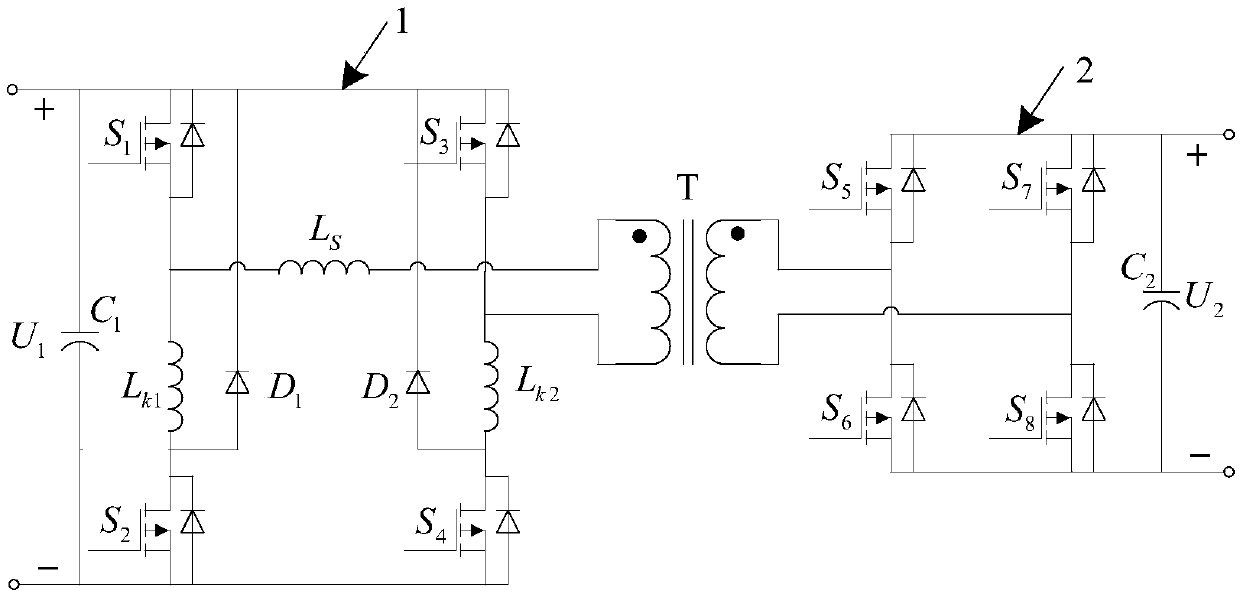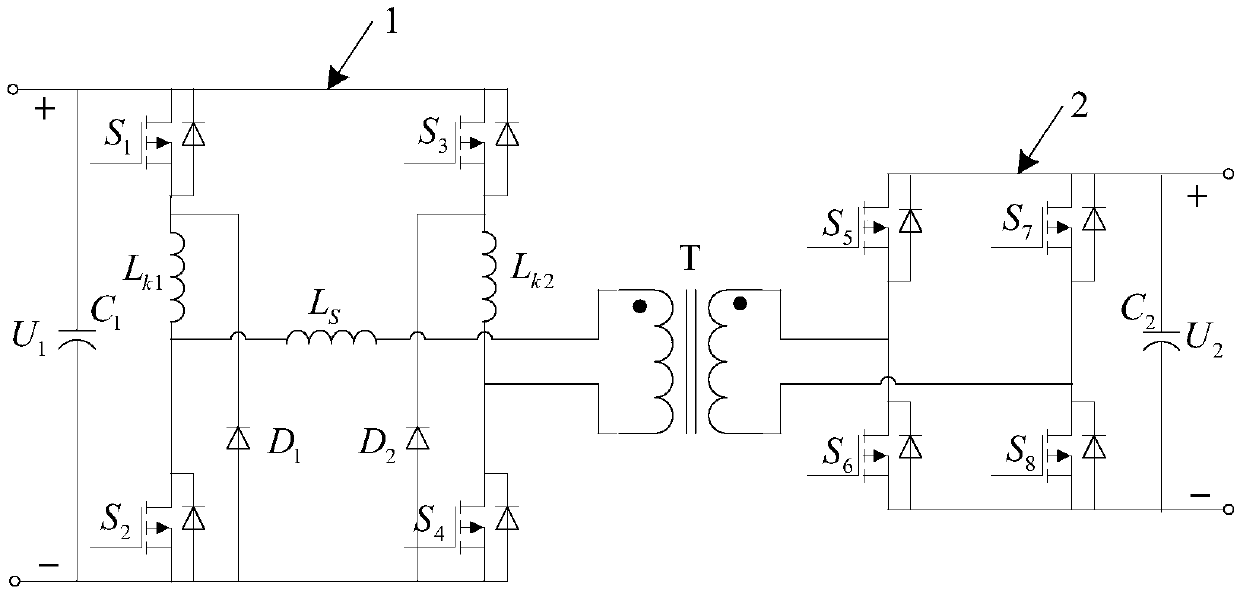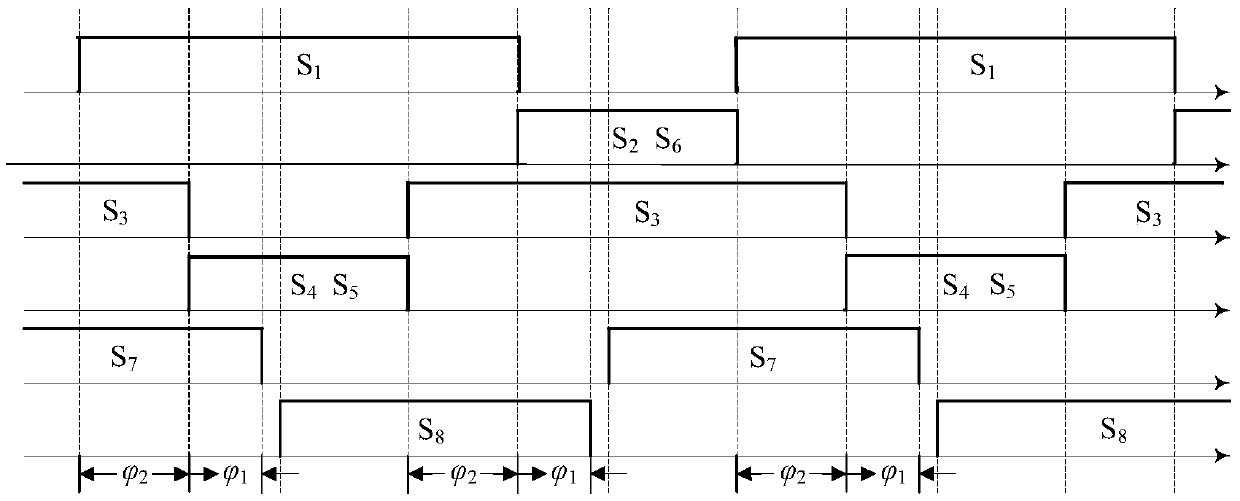An isolated bidirectional dc-dc converter
A DC-DC and converter technology, applied in the field of isolated bidirectional DC-DC converters, can solve the problems of the control effect not meeting the requirements, sacrificing the power transmission capability or soft switching characteristics of the converter, etc.
- Summary
- Abstract
- Description
- Claims
- Application Information
AI Technical Summary
Problems solved by technology
Method used
Image
Examples
Embodiment 1
[0055] Embodiment 1: first and second inductance L k1 , L k2 The other end is connected to the busbar as the first structure, when the energy from U 1 Lateral U 2 Each switching mode during side transmission, one cycle can be divided into 6 switching modes, among which the first 3 switching modes and the last 3 switching modes are semi-circularly symmetrical, so only the first 3 switching modes need to be analyzed. Can. where the primary side regulator capacitor C 1 The voltage across the terminal is U 1 , the secondary side regulator capacitor C 2 The voltage across the terminal is U 2 .
[0056] In this example, if image 3 As shown, the first power switch S 1 and the second power switch S 2 The driving pulse is complementary, the first power switch S 1 The drive pulse width is always greater than the second power switch S 2 the drive pulse width. The third power switch tube S 3 and the fourth power switch S 4 The driving pulse is complementary, the third powe...
Embodiment 2
[0060] Embodiment 2: first and second inductance L k1 , L k2 The other end is connected to the busbar as the first structure, when the energy from U 2 Lateral U 1 Each switching mode during side transmission, one cycle can be divided into 6 switching modes, among which the first 3 switching modes and the last 3 switching modes are semi-circularly symmetrical, so only the first 3 switching modes need to be analyzed. Can. Primary side regulator capacitor C 1 The voltage across the terminal is U 1 , the secondary side regulator capacitor C 2 The voltage across the terminal is U 2 .
[0061] In this example, if Figure 7 As shown, the first power switch S 1 , the third power switch tube S 3 Always in off state, no need to provide drive pulse. Fifth power switch tube S 5 , the sixth power switch tube S 6 The driving pulses are complementary, the pulse widths are equal and there is a dead time; the seventh power switch tube S 7 , the eighth power switch tube S 8 The d...
Embodiment 3
[0066] Embodiment 3: first and second inductance L k1 , L k2 The other end is connected to the busbar as the second structure, when the energy is from U 1 Lateral U 2 Each switching mode during side transmission, one cycle can be divided into 6 switching modes, among which the first 3 switching modes and the last 3 switching modes are semi-circularly symmetrical, so only the first 3 switching modes need to be analyzed. Can. Primary side regulator capacitor C 1 The voltage across the terminal is U 1 , the secondary side regulator capacitor C 2 The voltage across the terminal is U 2 .
[0067] In this example, if Figure 11 As shown, the first power switch S 1 and the second power switch S 2 The driving pulse is complementary, the second power switch S 2 The driving pulse width is always greater than the first power switch S 1 The driving pulse width; the third power switch S 3 and the fourth power switch S 4 The driving pulse is complementary, the fourth power swi...
PUM
 Login to View More
Login to View More Abstract
Description
Claims
Application Information
 Login to View More
Login to View More - R&D
- Intellectual Property
- Life Sciences
- Materials
- Tech Scout
- Unparalleled Data Quality
- Higher Quality Content
- 60% Fewer Hallucinations
Browse by: Latest US Patents, China's latest patents, Technical Efficacy Thesaurus, Application Domain, Technology Topic, Popular Technical Reports.
© 2025 PatSnap. All rights reserved.Legal|Privacy policy|Modern Slavery Act Transparency Statement|Sitemap|About US| Contact US: help@patsnap.com



